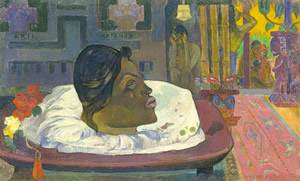
A Highly Important Wood Sculpture of Dainichi Nyorai
Kamakura period (1190s), attributed to Unkei (d. 1223)
estimate: $1,500,000-2,000,000

Park Sookeun
Mother, child and two women
estimate: $500,000-600,000
JAPANESE AND KOREAN ART AT CHRISTIE’S NEW YORK PRESENTS MOST VALUBLE WORKS OFFERED IN THE CATEGORY
Japanese and Korean Art auction at Christie’s New York, March 18th 2008
]]>
March 8th 2008 – Commencing the Asia Week sales at Christie’s in New York, the March 18 auction of Japanese and Korean Art will present some of the most valuable works ever offered in the category. A newly discovered wood sculpture of Dainichi Nyorai, the supreme Buddha, attributed to the sculptor Unkei, is the most valuable work ever offered in the category (estimate: $1.5 – 2 million). Other highlights are two paintings by Park Sookeun, the most sought after Korean master, and a collection of approximately 45 lots of Japanese swords, sword fittings and helmets from The Metropolitan Museum of Art will be sold with no reserve. With over 450 lots, the sale expects to realize in excess of $7 million U.S. dollars.
Thought to be the work of Unkei, the seated figure of Dainichi Nyorai, the supreme Buddha of the esoteric pantheon, is preserved in fine condition. Unkei was one of the greatest carvers of the early Kamakura period (1190s), who received the title of hoin, the highest rank an artist could achieve. Dainichi is classified as a Buddha, and here he is presented as a Bodhisattva in princely regalia. Made of Cyprus wood, he sits on lotus position, with hair piled in a high topknot and wearing the crown and jewelry of royalty. The deity forms a distinctive hand gesture, called “knowledge fist:” his left hand forms a fist with the index finger pointing up and grasped by his right hand.
The statue is believed to have come from a temple during the Meiji period (1868-1911) when the government officially adopted Shinto as the state religion. Upon leaving the temple, it was a part of a prominent family collection in the northern part of the Kanto region. The statue’s existence was unknown until it was later sold to a Buddhist dealer and bought by the current owner. Suspecting the figure was hollow inside, the owner approached the curator at the Tokyo National Museum and it was discovered by X-rays that the figure contains three dedicatory objects, sealed inside the torso for over 800 years.
KOREAN ART: Leading the group of 20 Korean modern and contemporary paintings are two of the most important works by Park Sookeun to appear at auction. Heakyum Kim, Specialist of Korean Art comments, “Park Sookeun is the most important and well-recognized Korean artist of the twentieth century. His paintings are very rare on the market, approximately 400 paintings were made in his short lifetime, and Christie’s is honored to be offering two exquisite paintings.” Christie’s holds the current auction record for the artist with Seated woman and jar, 1962, which realized $1,239,500 in March 2004.
Americans stationed in Seoul during the 1960s appreciated Sookeun’s work, and the paintings offered in the sale were bought for approximately thirty dollars a piece. Mother, child and two women, 1964, (estimate: $500,000-600,000) and Coming home from market, 1965, (estimate: $400,000-500,000) portray the artist’s unassuming and simplistic trademark renderings of figures wearing traditional Korean clothing.
Follow us on:

